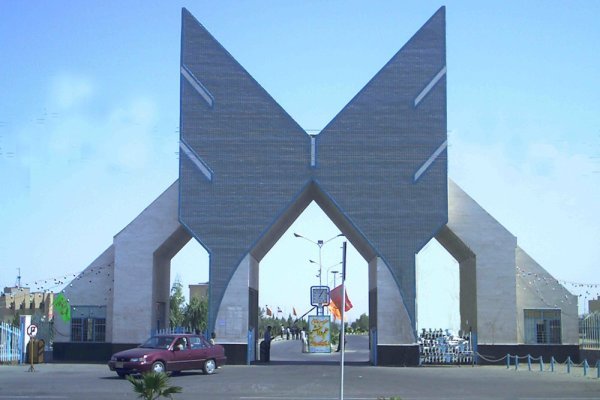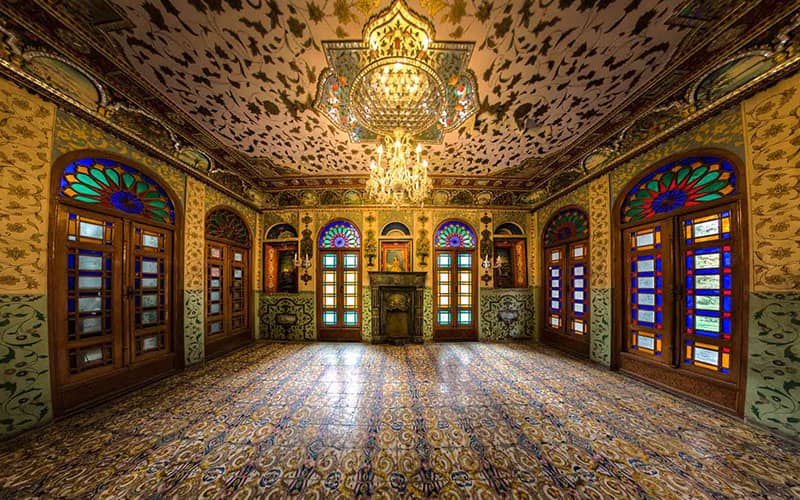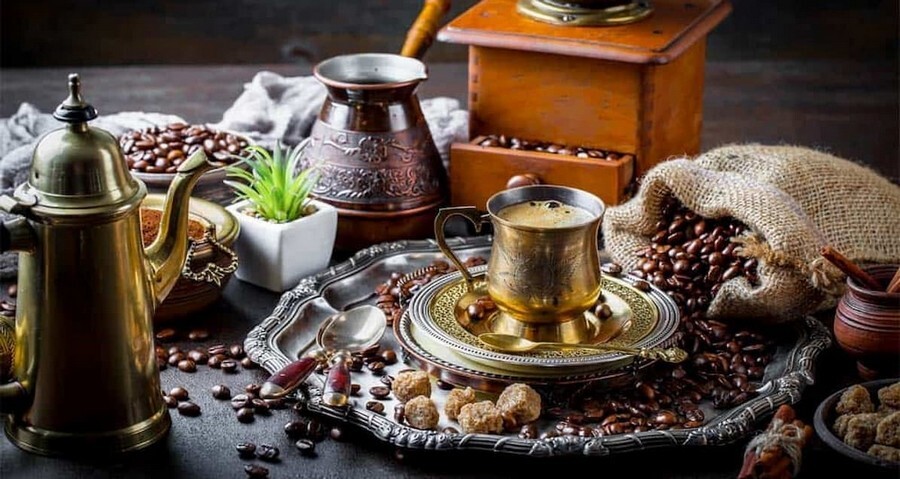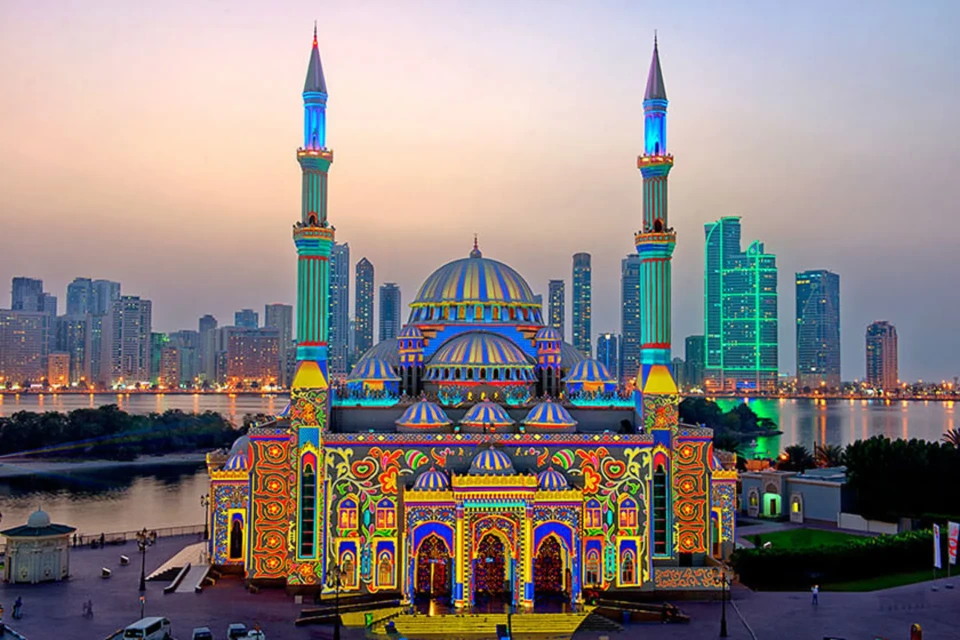Where is the National Jewelry Museum? A Meeting with Historical Jewels
The National Jewelry Museum, one of Tehran’s top attractions, is housed in the basement of the Central Bank of Iran. This museum, filled with valuable artifacts like Naderi’s aigrette, the Kiani Crown, the Shahbanu Crown, and the jeweled globe, attracts many tourists.

Introduction to the National Jewelry Museum
The National Jewelry Museum in Tehran preserves a collection of Iran’s precious treasures and artifacts passed down from previous generations. Many achievements and spoils of past kings are stored here, making it a must-visit for those interested in historical valuable items.
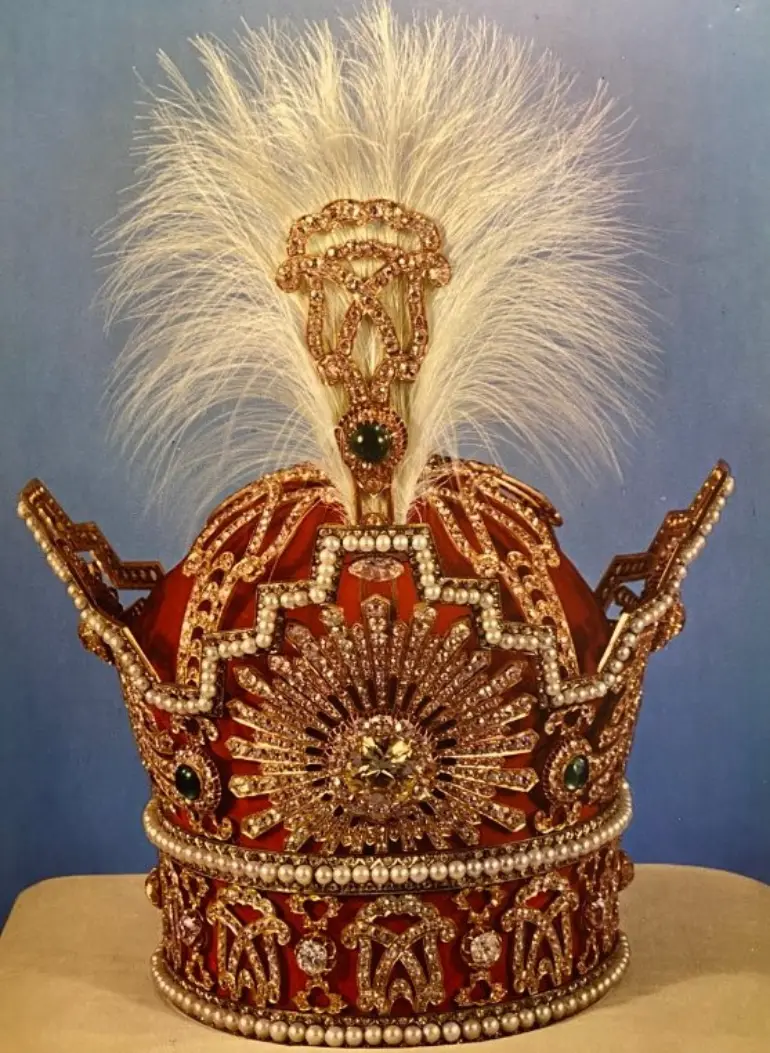
Location of the National Jewelry Museum
As mentioned, the museum is located in the basement of the Central Bank of Iran, which is responsible for preserving these valuable artifacts. Although the building used to be one of Iran’s oldest banks, it has now been converted into a museum open to the public.
Address: Tehran – Imam Khomeini Square – Ferdowsi Street – Before Istanbul Crossroad – Opposite the Turkish Embassy – Central Bank of Iran Building – National Jewelry Museum
Phone Numbers: +98 21 64463030, +98 21 64463785
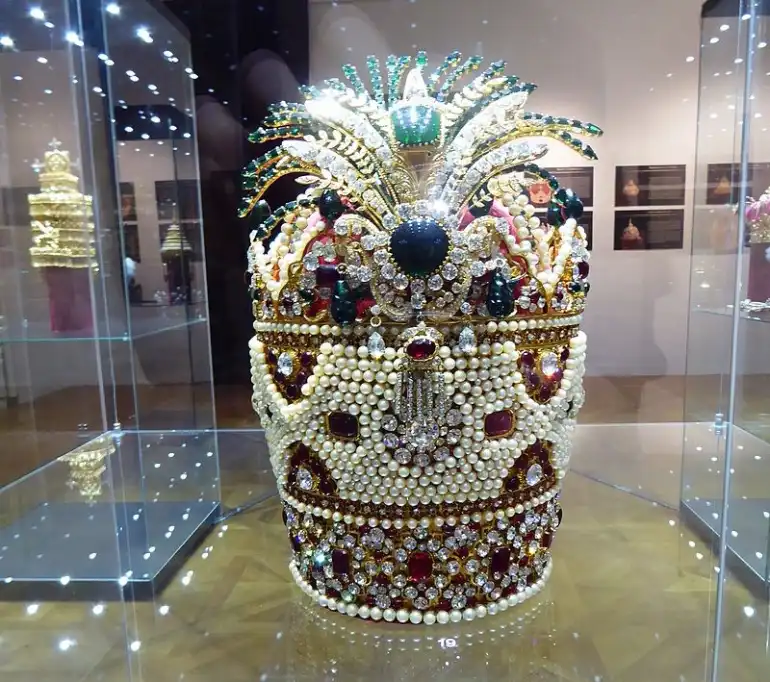
How to Access the National Jewelry Museum
You can reach the museum by taxi, metro, bus, or personal car. For those driving or using an online taxi service, simply use the provided location.
Getting to the National Jewelry Museum by Metro
First, go to the Imam Khomeini metro station via lines 1 or 2. After disembarking, take the Republic – Baharestan bus to Republic Square and get off at Istanbul Crossroad. The museum is a short 200-meter walk west on Republic Street from there.
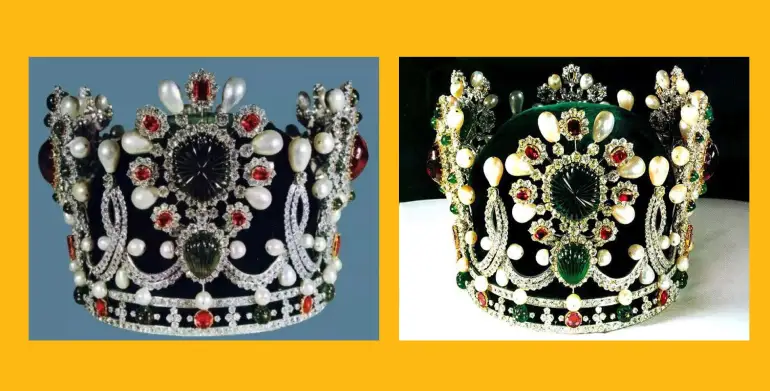
Getting to the National Jewelry Museum by Bus
Use bus lines that take you to Republic Square and get off at Istanbul Crossroad. The remaining distance can be covered on foot.
Best Time to Visit the National Jewelry Museum
Tehran is a busy city with traffic and crowds. The quietest times are likely during the Nowruz holidays. While summer is very hot, the museum has air conditioning, allowing you to comfortably view the artifacts.
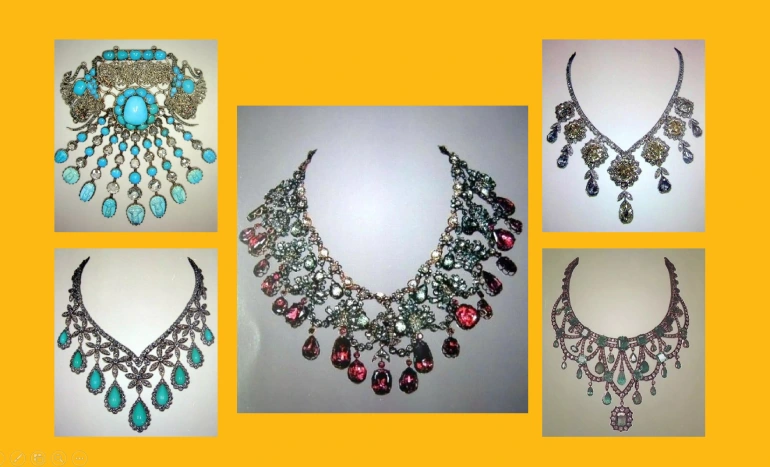
Operating Hours of the National Jewelry Museum
The museum is open from Saturday to Tuesday, 2 PM to 5 PM. It is closed on Wednesdays, Thursdays, Fridays, and public holidays. It’s recommended to call the automated line at +98 21 64464700 for updated information before your visit.
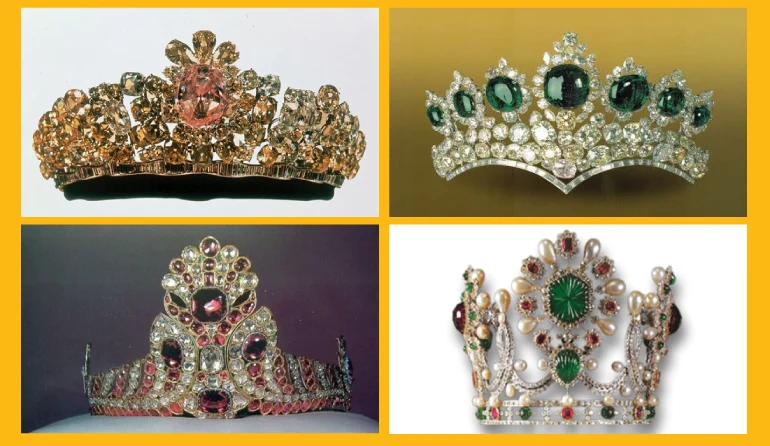
Buying Tickets for the National Jewelry Museum
Tickets must be purchased in person. They are cheaper for students and schoolchildren. For group visits (more than 10 people), advance booking is required to benefit from a free museum guide.

History of the National Jewelry Museum
The museum’s history began with collecting decorative and valuable items. Before the Safavid era, kings did not focus on collecting and preserving expensive artifacts. This changed during the Safavid period. Many of the jewels now housed in the museum were purchased or seized by kings of the past.
Some jewels were taken out of Iran by Mahmoud Afghan but were returned by Nader Shah Afshar, who even attacked India to retrieve jewels sent there by Mahmoud Afghan. Nader Shah donated some of these jewels to the Astan Quds Razavi and gave others to his war commanders. However, some jewels were later stolen by looters and are now kept in England.
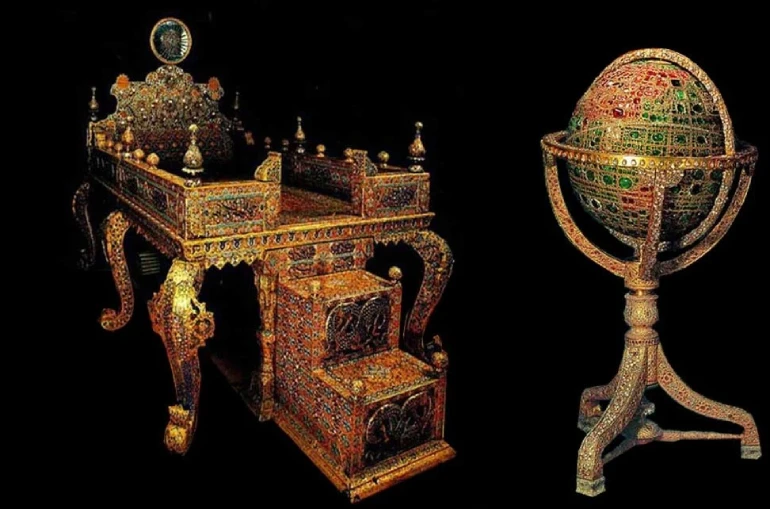
During the Qajar and Pahlavi periods, the tradition of preserving valuable jewels continued. Fath-Ali Shah Qajar, known for his love of jewels and gemstones, commissioned the construction of the Naderi Throne, Peacock Throne, and Kiani Crown. Naser al-Din Shah also added 48 large yellow diamonds to the collection and commissioned the jeweled globe.
Before the Pahlavi era, these valuable items were kept in the royal palace. However, in 1937, the National Bank of Iran building was established, which is now known as the National Jewelry Museum. These items were once used as collateral for national currency and government debt documents but were later displayed to the public in 1943.
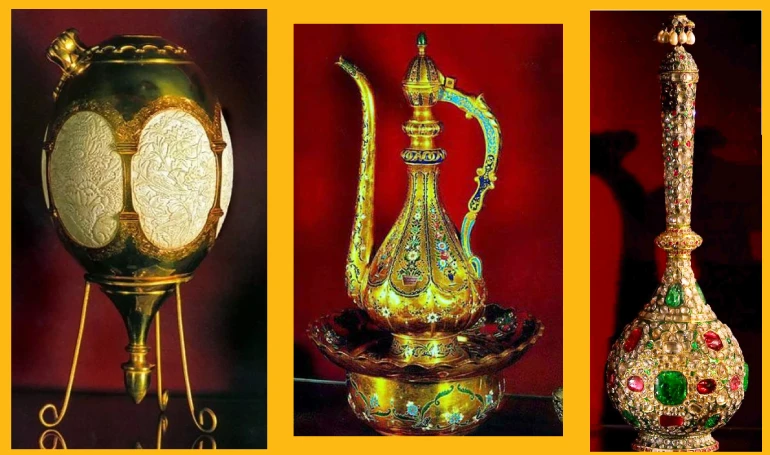
Architecture of the National Jewelry Museum
The building housing the National Jewelry Museum was designed by German architects and combines both Iranian and European architectural styles.
This two-story brick building includes a basement where the valuable artifacts are stored, making it a three-story structure in total. Some aspects of the building resemble Achaemenid patterns, notably the tall columns and the stone reliefs of Persian soldiers at the entrance.
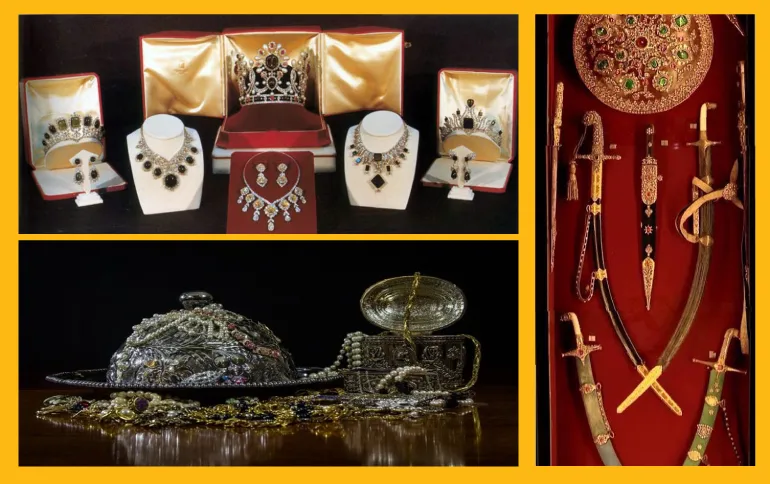
Interestingly, the lion statues at the entrance of the Central Bank building were added later, giving visitors the impression of guards protecting the precious items inside. These statues also hint at Iranian and Baroque architectural styles. Other parts of the building were constructed following European architecture.
The construction of this edifice took six years, initially built in a T-shape, with northern and southern wings added later. The main entrance is taller than the rest of the building and made of stone. The exterior features marble stone bases, two meters high, in front of the building.
The entrance area, with its four stone columns topped with bull figures, is inspired by the capitals of Persepolis and the Palace of Susa. However, the European architectural style is evident inside the building. The main hall, with its high ceiling and vertical skylights, resembles Baroque European buildings.
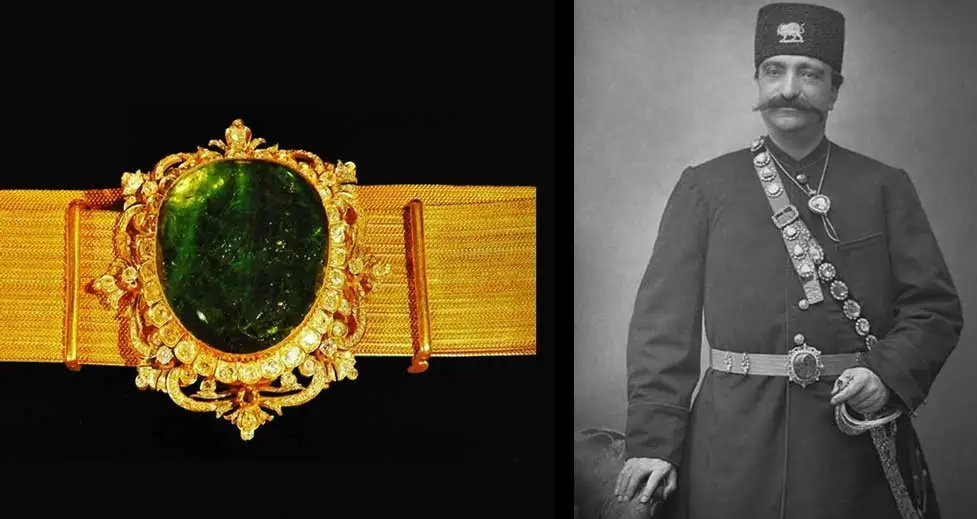
Artifacts Preserved in the National Jewelry Museum
The museum houses a collection of valuable items related to past emperors and kings. It’s said that all these jewels are kept in 36 treasuries within the museum, showcasing a diverse array of items that can captivate visitors for hours.
Notable artifacts include canes, medals, thrones, brooches, pearls, pen cases, snuff boxes, ruby and garnet-embellished items, food covers, hookahs, mirrors, enamel jugs, candelabras, vases, turquoise, various decorative jewelry, crowns, tiaras, aigrettes, swords, daggers, shields, watches, and guns.
Some of the most famous and popular jewels in this museum include:
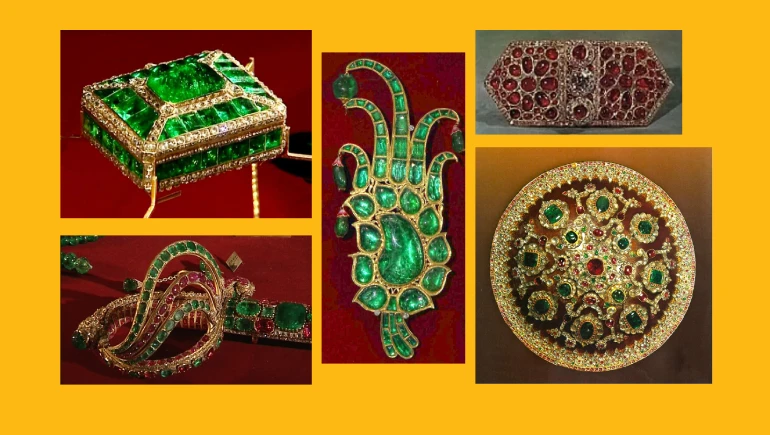
Pahlavi Crown
One of the most spectacular jewels in the National Jewelry Museum is the crown worn by the two Pahlavi kings. This crown, made of gold and silver, is adorned with sapphires, diamonds, pearls, and large emeralds. The cap is made of red velvet with several cabochon emeralds.
What makes this crown significant is its resemblance to the crowns of the Sassanian kings. The four-tiered steps and golden sunburst with diamond rays under the steps evoke the power and grandeur of ancient Iran. The crown contains 3,380 diamonds weighing 1,144 carats, 2 sapphires weighing 19 carats, and 5 emeralds weighing 199 carats. Reza Shah, disinterested in the Qajar Kiani Crown, ordered a new, special crown for himself.
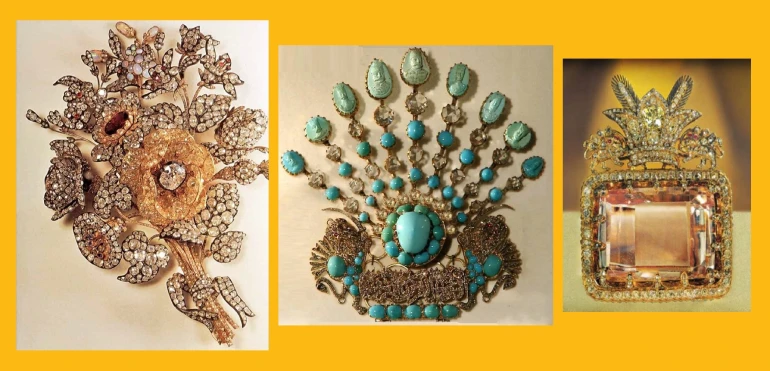
Naderi Aigrette
Another valuable and precious item in the National Jewelry Museum is the Naderi Aigrette. This piece features a large green cabochon emerald that immediately captures attention. Three other tear-shaped green emerald pendants and two more emeralds are at the aigrette’s tips. The aigrette is decorated with small and large diamonds, weighing about 134 grams.
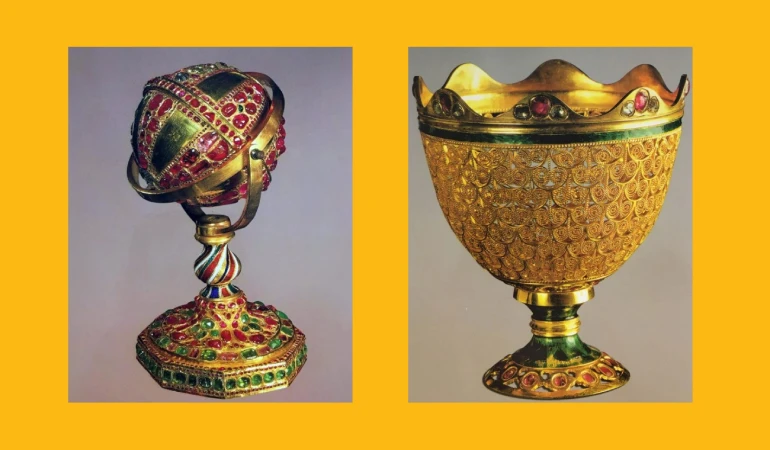
Kiani Crown
This crown was made by order of Fath-Ali Shah Qajar in 1212 AH (1797-1798) and is adorned with emeralds, rubies, diamonds, and pearls. Successive Qajar kings also wore this crown. It is said to be the first crown made in this style after the Sassanian era.

Royal Sword
This sword, used during coronations and special ceremonies, is decorated with diamonds, rubies, and emeralds.
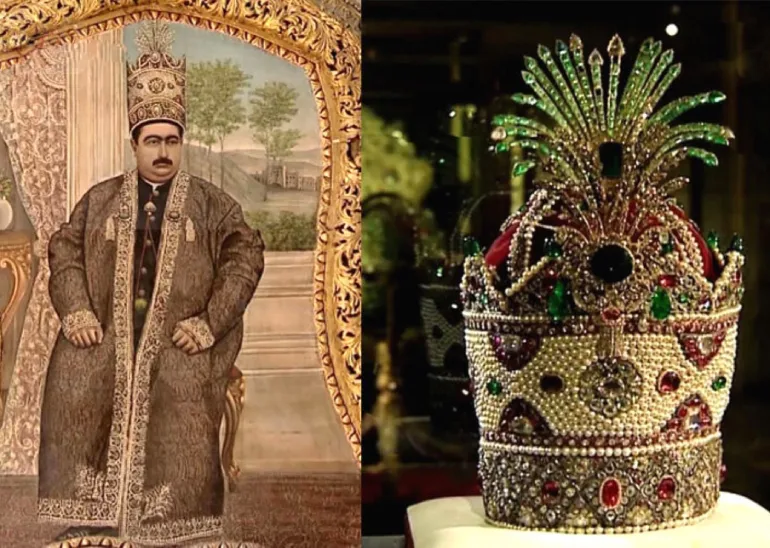
Jeweled Globe
This statue of the globe was made in 1874 by Naser al-Din Shah and created by Ibrahim Moshi, a skilled jeweler of the time, along with several others. It contains 34 kilograms of pure gold and 3,656 grams of precious stones, totaling 51,366 pieces. The stones are so bright and shiny that identifying the countries on the globe is challenging. Emeralds represent the seas, rubies the lands, bright rubies India, sapphires Central and Southern Africa, and diamonds Southeast Asia, Iran, and England. The equator is indicated by cut diamonds.

Peacock Throne (Sun Throne)
The Sun Throne, also known as the Peacock Throne, was made by order of Fath-Ali Shah Qajar and resembles a royal seat with curved lion-like legs. This piece was crafted by the skilled jeweler Mohammad Hussein Khan Sadr Isfahani. Initially called the Sun Throne, it was renamed the Peacock Throne after Fath-Ali Shah married Taj al-Dawlah. Later, when it was passed to Naser al-Din Shah, he ordered repairs and inscriptions in Nastaliq script with azure enamel to be added. This throne was kept in the Golestan Palace Hall until 1981, when it was moved to the National Jewelry Museum.
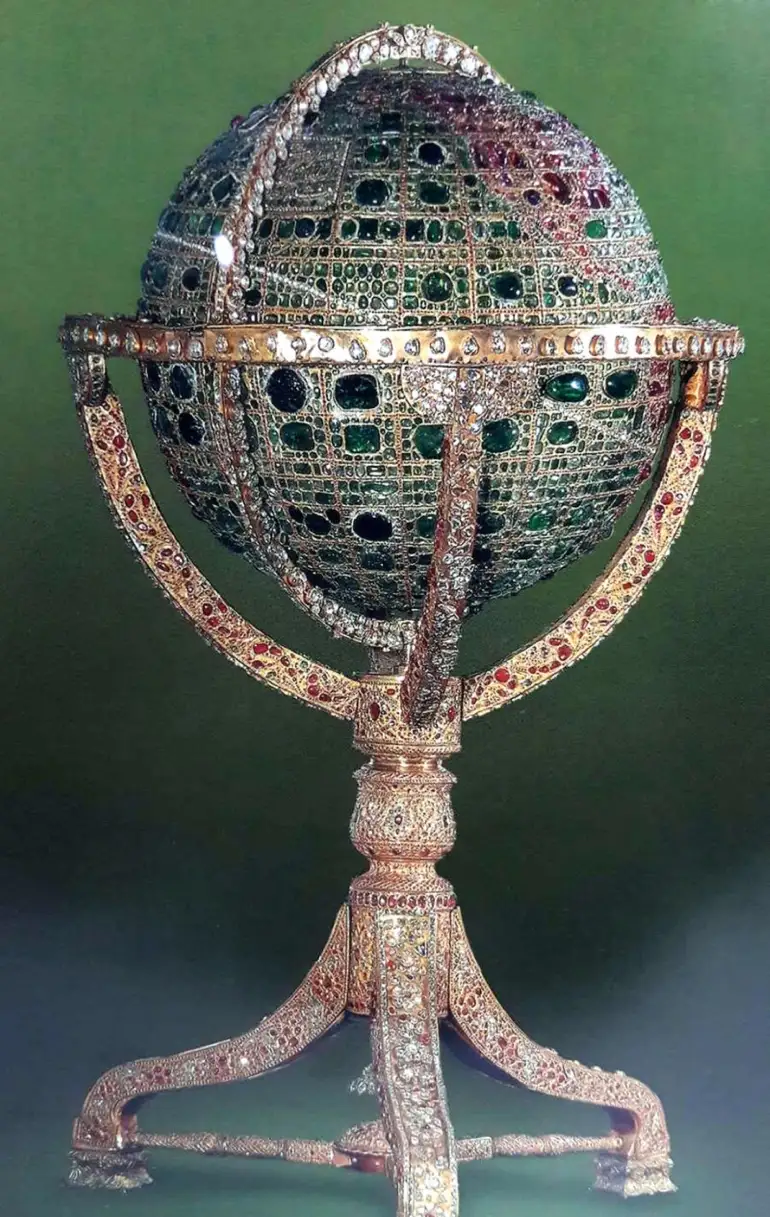
Other Treasures of the National Jewelry Museum
In addition to the items mentioned above, the museum holds other artifacts made of precious stones, gold, and silver. These include:
Candelabras
Swords and daggers
Naderi shield
Brooches and pins
Badges and medals
Royal capes and hats
Food utensils
Jeweled jugs and hookahs
Royal aigrettes
Perfume bottles
Watches
Jewelry boxes
Curtain holders
Inlaid washbasins
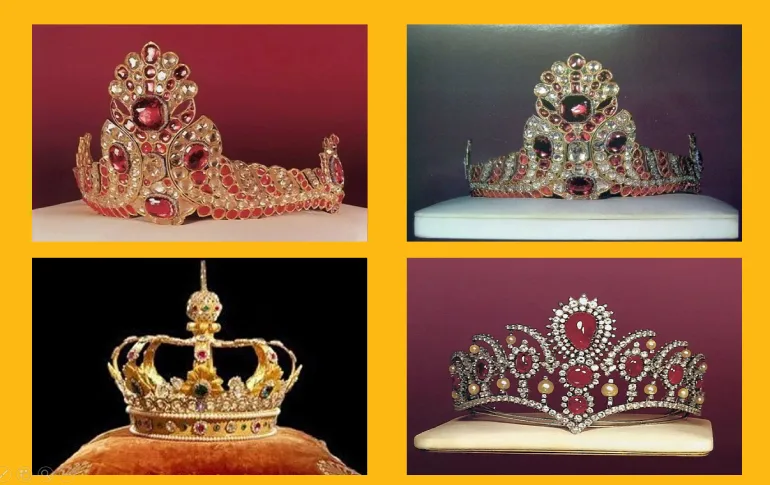
Nearby Attractions to the National Jewelry Museum
While visiting the National Jewelry Museum, you can also explore other tourist attractions in Tehran, such as:
House of Sardar Assad Bakhtiari
Located 4.9 km from the National Jewelry Museum, this house was built in 1912 and belonged to Sardar Assad Bakhtiari, a conqueror of Tehran during the Constitutional Revolution. It is considered one of Tehran’s most beautiful residential houses and attracts many visitors.
National Bank Museum
This museum is in the same building as the National Jewelry Museum, located on the upper floors.
Amin al-Sultan Mansion
This historic building was constructed during the Qajar period and features architecture from that era. It has entrances and exits on both sides, with the main entrance leading to Lalehzar Street. The interior has a garden, stucco work, and brick walls reminiscent of Qajar architecture. Although it was set on fire during the 1953 coup, it was later restored. The mansion is 4.9 km from the National Jewelry Museum, a 20-minute drive.
Negarestan Garden Museum
Another beautiful spot in Tehran near the National Jewelry Museum is the Negarestan Garden Museum, built in 1807 by order of Fath-Ali Shah. Upon entering the courtyard, a large pool in the center immediately catches your attention.
Inside the building, you will notice the architectural style of the Kolah Farangi pavilion. Delgosha and Ghalamdan Hall are two historical buildings located here. Due to its pleasant climate, this place was Fath-Ali Shah’s summer residence.
The museum houses numerous artworks, including works by Mirza Jani the Painter, Mirza Baba the Painter, and Abdullah Khan. Additionally, old artifacts, including dishes, are also kept in this garden museum.
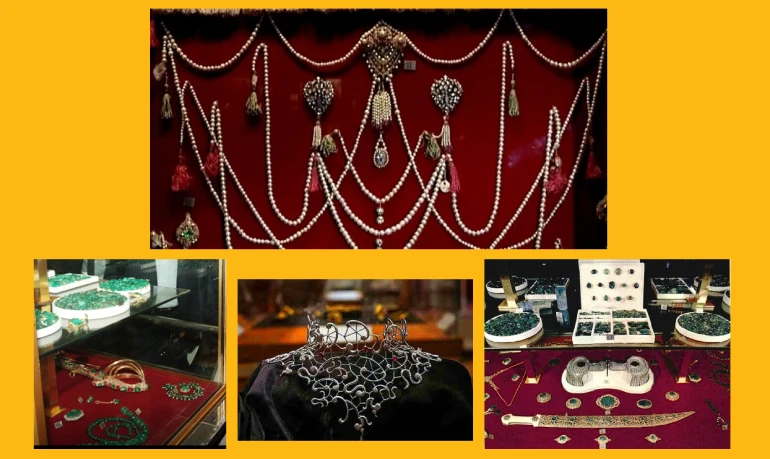
Masoudieh Mansion
Another Qajar-era building near the National Jewelry Museum is the Masoudieh Mansion. It was built by order of Masoud Mirza (son of Naser al-Din Shah) and served as a place to host foreign guests.
The Masoudieh Mansion is constructed in the Qajar architectural style, showcasing the craftsmanship of plasterers, tile workers, and woodcarvers of that era. This mansion is located a short distance from the National Jewelry Museum.
Accommodation Near the National Jewelry Museum
If you plan to visit this beautiful and historic building, staying at one of the hotels near the museum is recommended:
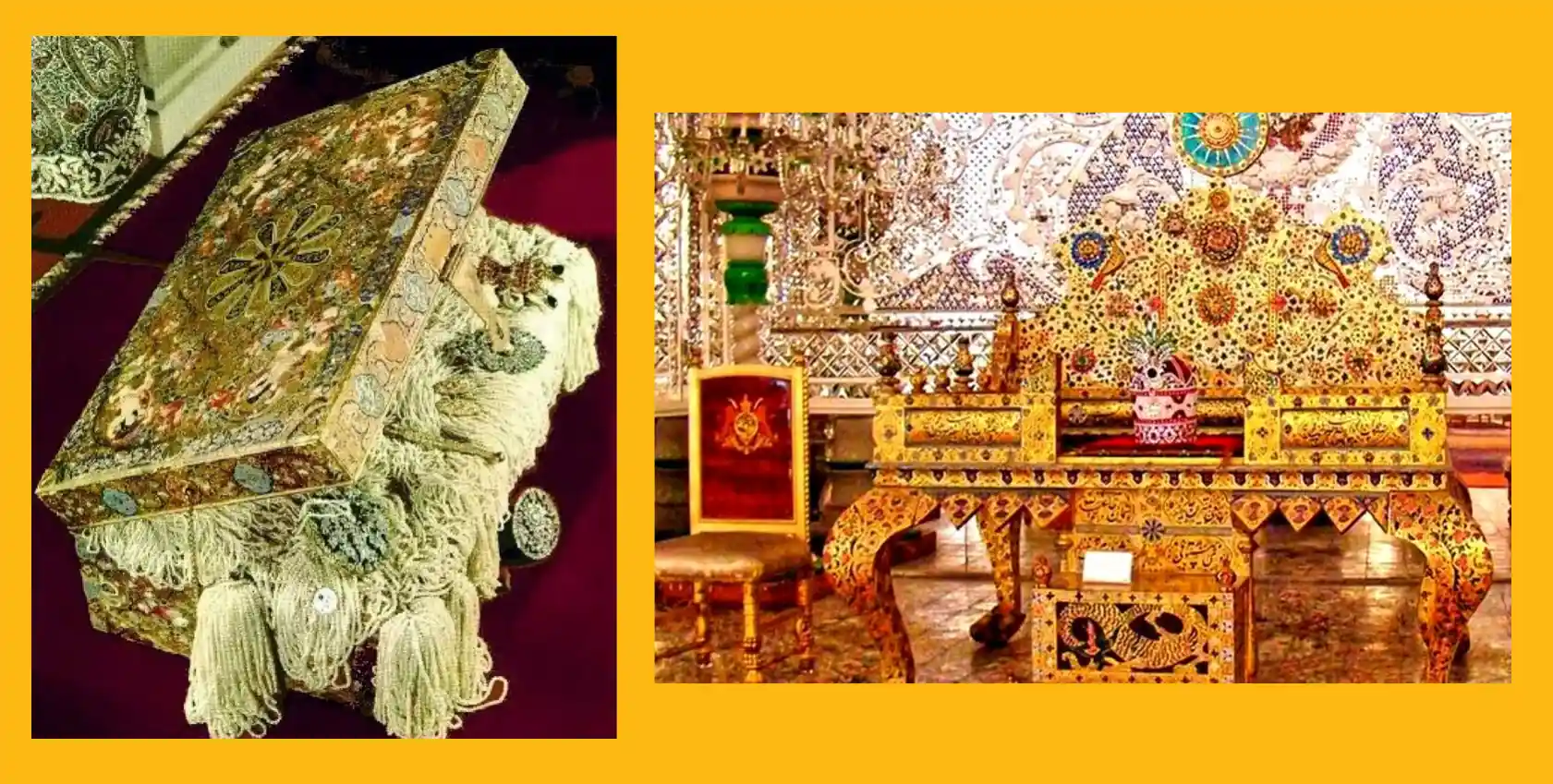
Hafez Hotel
This two-star hotel is 500 meters from the National Jewelry Museum. The advantages of staying here include easy access to the Grand Bazaar of Tehran, the National Museum of Iran, the Coin and Jewelry Museum, Golestan Palace, and the central metro station.
Address: South Ferdowsi Street, National Bank Alley, No. 18
Saadi Hotel
This hotel is 400 meters from the National Jewelry Museum. This two-star hotel has been operating since 1977, and its building has been renovated several times over the years. The hotel has adequate facilities to host tourists.
Address: Jomhouri Eslami Street, between Istanbul Intersection and Mokhber al-Dawleh Intersection, beginning of Lalehzar Street, No. 367
Naderi New Hotel
This hotel is 500 meters from the National Jewelry Museum and has been operating since 1972. This two-star hotel has 7 floors and 59 rooms and suites with suitable amenities for hosting travelers.
Address: Jomhouri Eslami Street, after Si-e Tir, before Istanbul Intersection, Goharshad Alley, No. 39
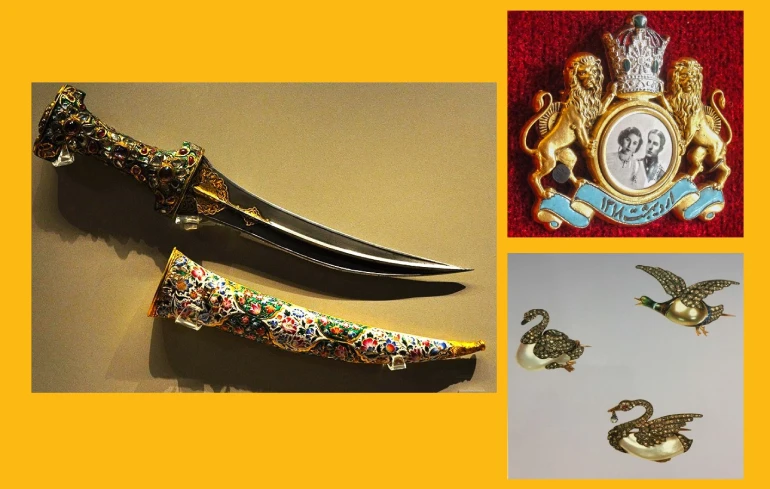
Central Hotel Iran
Another excellent accommodation in Tehran near the Central Bank’s National Jewelry Museum. This hotel is popular among travelers due to its proximity to metro and BRT stations and easy access to commercial centers, including the Grand Bazaar of Tehran, government offices, and major hospitals.
Address: District 12, New Lalehzar, before Manoochehri, below Crystal Cinema
Parasto Hotel
Another accommodation located 800 meters from the National Jewelry Museum in Tehran is the Parasto Hotel. This hotel has been operating since 1969 and, with its two floors and 22 rooms, hosts tourists visiting the Jewelry Museum.
Address: Tehran, Jomhouri Street, after Hafez Bridge, Keykhosro Shahrkh Alley, No. 11
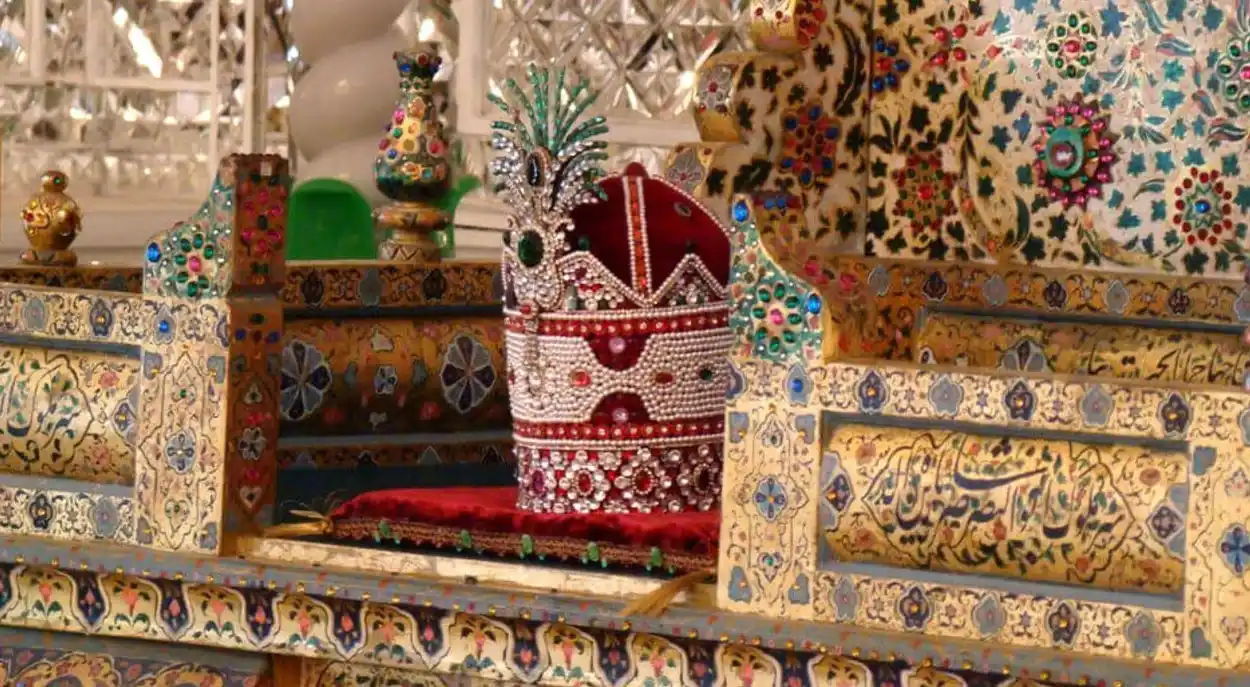
Recommendations for Visiting the National Jewelry Museum
Before visiting the museum, keep the following points in mind:
Visits are only allowed for individuals over 12 years old.
Bringing mobile phones or cameras is prohibited during the visit.
Tickets are sold in person.
Upon entering the building, you will encounter security gates, after which you can proceed to the hall with the help of a guard.


